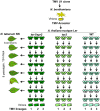Experimental virus evolution reveals a role of plant microtubule dynamics and TORTIFOLIA1/SPIRAL2 in RNA trafficking
- PMID: 25133612
- PMCID: PMC4136834
- DOI: 10.1371/journal.pone.0105364
Experimental virus evolution reveals a role of plant microtubule dynamics and TORTIFOLIA1/SPIRAL2 in RNA trafficking
Abstract
The cytoskeleton is a dynamic network composed of filamentous polymers and regulatory proteins that provide a flexible structural scaffold to the cell and plays a fundamental role in developmental processes. Mutations that alter the spatial orientation of the cortical microtubule (MT) array of plants are known to cause important changes in the pattern of cell wall synthesis and developmental phenotypes; however, the consequences of such alterations on other MT-network-associated functions in the cytoplasm are not known. In vivo observations suggested a role of cortical MTs in the formation and movement of Tobacco mosaic virus (TMV) RNA complexes along the endoplasmic reticulum (ER). Thus, to probe the significance of dynamic MT behavior in the coordination of MT-network-associated functions related to TMV infection and, thus, in the formation and transport of RNA complexes in the cytoplasm, we performed an evolution experiment with TMV in Arabidopsis thaliana tor1/spr2 and tor2 mutants with specific defects in MT dynamics and asked whether TMV is sensitive to these changes. We show that the altered cytoskeleton induced genetic changes in TMV that were correlated with efficient spread of infection in the mutant hosts. These observations demonstrate a role of dynamic MT rearrangements and of the MT-associated protein TORTIFOLIA1/SPIRAL2 in cellular functions related to virus spread and indicate that MT dynamics and MT-associated proteins represent constraints for virus evolution and adaptation. The results highlight the importance of the dynamic plasticity of the MT network in directing cytoplasmic functions in macromolecular assembly and trafficking and illustrate the value of experimental virus evolution for addressing the cellular functions of dynamic, long-range order systems in multicellular organisms.
Conflict of interest statement
Figures


Similar articles
-
Helical growth of the Arabidopsis mutant tortifolia1 reveals a plant-specific microtubule-associated protein.Curr Biol. 2004 Aug 24;14(16):1515-21. doi: 10.1016/j.cub.2004.08.033. Curr Biol. 2004. PMID: 15324671
-
The Microtubule-Associated Protein IQ67 DOMAIN5 Modulates Microtubule Dynamics and Pavement Cell Shape.Plant Physiol. 2018 Aug;177(4):1555-1568. doi: 10.1104/pp.18.00558. Epub 2018 Jul 5. Plant Physiol. 2018. PMID: 29976837 Free PMC article.
-
Interaction of the microtubule-associated host protein HIP2 with viral helper component proteinase is important in infection with potato virus A.Mol Plant Microbe Interact. 2013 Jul;26(7):734-44. doi: 10.1094/MPMI-01-13-0023-R. Mol Plant Microbe Interact. 2013. PMID: 23489059
-
Microtubule organization and microtubule-associated proteins in plant cells.Int Rev Cell Mol Biol. 2014;312:1-52. doi: 10.1016/B978-0-12-800178-3.00001-4. Int Rev Cell Mol Biol. 2014. PMID: 25262237 Review.
-
Microtubules in viral replication and transport.Plant J. 2013 Jul;75(2):290-308. doi: 10.1111/tpj.12134. Epub 2013 Mar 22. Plant J. 2013. PMID: 23379770 Review.
Cited by
-
Tobacco Mosaic Virus Movement: From Capsid Disassembly to Transport Through Plasmodesmata.Viruses. 2025 Jan 31;17(2):214. doi: 10.3390/v17020214. Viruses. 2025. PMID: 40006969 Free PMC article. Review.
-
Detection of Plant Viruses and Disease Management: Relevance of Genetic Diversity and Evolution.Front Plant Sci. 2020 Jul 17;11:1092. doi: 10.3389/fpls.2020.01092. eCollection 2020. Front Plant Sci. 2020. PMID: 32765569 Free PMC article. Review.
-
A novel block of plant virus movement genes.Mol Plant Pathol. 2017 Jun;18(5):611-624. doi: 10.1111/mpp.12418. Epub 2016 Jul 15. Mol Plant Pathol. 2017. PMID: 27118327 Free PMC article.
-
Susceptibility Genes to Plant Viruses.Viruses. 2018 Sep 10;10(9):484. doi: 10.3390/v10090484. Viruses. 2018. PMID: 30201857 Free PMC article. Review.
-
Function of Plasmodesmata in the Interaction of Plants with Microbes and Viruses.Methods Mol Biol. 2022;2457:23-54. doi: 10.1007/978-1-0716-2132-5_2. Methods Mol Biol. 2022. PMID: 35349131
References
-
- Murata T, Sonobe S, Baskin TI, Hyodo S, Hasezawa S, et al. (2005) Microtubule-dependent microtubule nucleation based on recruitment of gamma-tubulin in higher plants. Nat Cell Biol 7: 961–968. - PubMed
-
- Shaw SL, Kamyar R, Ehrhardt DW (2003) Sustained microtubule treadmilling in Arabidopsis cortical arrays. Science 300: 1715–1718. - PubMed
-
- Nakamura M, Ehrhardt DW, Hashimoto T (2010) Microtubule and katanin-dependent dynamics of microtubule nucleation complexes in the acentrosomal Arabidopsis cortical array. Nat Cell Biol 12: 1064–1070. - PubMed
Publication types
MeSH terms
Substances
LinkOut - more resources
Full Text Sources
Other Literature Sources
Molecular Biology Databases

